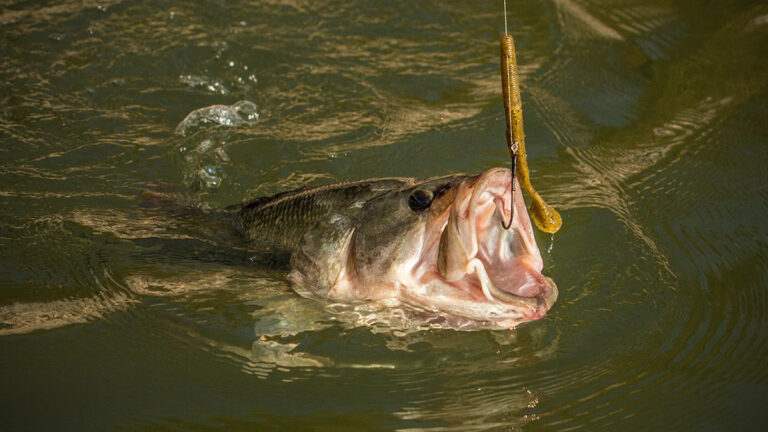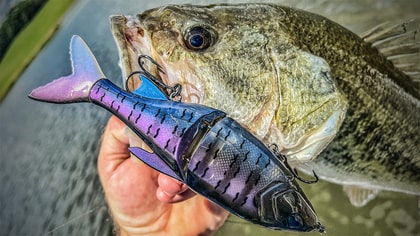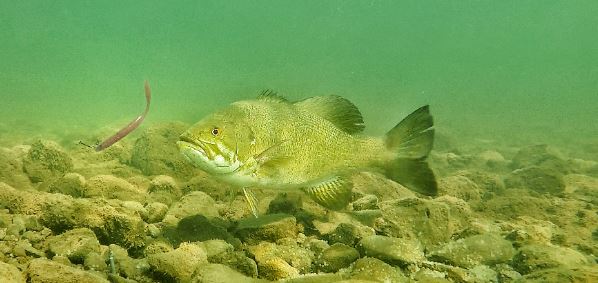Winter Bass Fishing from the Bank
Winter is by far the most difficult season for a bank angler.
As a bank fisherman myself, I have spent many years figuring out the best strategies and tools to implement when winter bass fishing from the bank.
And the most important thing I have learned is that you can certainly catch bass during the winter.
Once you know it can be done, you just need to figure out how to do it.
Where Do Bass go in the Winter?
During the winter months, bass go to deeper water. This is what makes winter bass fishing from the bank so difficult.
Anglers with a bass boat can simply drive out into deeper water and go straight to the fish. So how do bank fisherman overcome this?
You need to find deep areas of your pond that are within casting distance.
The easiest way to do this is to just cast out a jig or other quick sinking lure and just see how long your lure takes to hit the bottom.
Many ponds don’t have super deep water, so bass will drop to the lowest water column and hold the the bottom very tightly.
Any area where there is deeper water around your pond, bass will be stashed there.
Another way to find deep water is to use a portable fish finder like the “IBobber” which is a miniature fish finder that you cast out in to your pond.
One silver lining of winter fishing is that bass tend to school up and stay huddled in the same areas. So if you can find one bass, you have find lots of bass.
Warm Winter Day Bass Fishing
Warm winter days can be a huge opportunity to catch bass, especially for bank fishing. During these warm fronts, bass will move to shallow rock piles.
Rocks warm up very quickly and hold heat, so bass will move into these shallow rocky areas.
Bass will also have a quick boost in energy, metabolism, and aggression which leads to more bites.
What are Bass Eating in the Winter?
Bass primarily eat two things during the cold winter months. These are crawfish and shad. If you are a bank fishing, than you are probably fishing ponds and small lakes.
Pretty much all bodies of water have crawfish, but not all small ponds have shad.
If your pond does have shad, they are bass’s primary forage during the winter.
Shad do not handle cold weather very well at all, so when the water gets cold, they die off. Bass feast on dead or dying shad during the winter.
If your pond doesn’t have shad, crawfish are a winter favorite. Crawfish also do not like cold water temperature, so they will venture into deeper water.
So if the bass and crawfish are all compacted into the deeper water sections of the pond, bass are going to eat them.
Also Read: How to Know What Bass Are Feeding On
Fish Slow
Bass are very sluggish in cold water. They don’t have the energy to chase after fast moving prey.
Fish sinking and suspending lures that can be fished as slow as possible.
This might seem like a disadvantage, but it will actually help bank fisherman to make the most of the limited water available.
Take your time and work your lures very slowly and thoroughly through high percentage areas of the pond to maximize your success with these lethargic bass.
Stay Away from Wind
Wind is usually a good thing because it stirs up the water and can disorient baitfish that bass can then easily eat. However, in the winter, the wind cools down the water even further.
Stay on the side of your pond that is protected from the wind, because the fish will always congregate in as warm water as possible.
The calmer the water is, the warmer the water is, so the more fish are in that water.
Not only will you catch more fish out of the wind, but it will also keep you warmer and happier.
Best Lures for Winter Bank Fishing
Lure selection is paramount to winter bank fishing. Choose lures that can be fished deep, move slowly, and have a bigger profile.
Bass won’t waste energy chasing after a small little bait that won’t even satisfy them.
Think about it, it takes a lot of energy for these bass to move even a little bit in cold water.
So swimming over to eat a tiny bait might require more energy than the bait gives them.
1. Suspending Jerkbait
The suspending jerkbait is a staple of winter bass fishing. It perfectly resembles a dying baitfish and can be fished very very slow.
You can even dead stick a jerkbait for 20-30 seconds at a time to entice bass to bite.
I suggest a silent jekrbait in the winter because bass are a bit more finicky and more intimidated by loud lures.
2. Texas Rig
Texas rigs are classic rigs that work all year round. They catch bass even the most lockjaw bass.
I mostly use fluke and crawfish soft plastics in the winter. If you are able to find deep submerged cover in your pond, Texas rigs are your best bet for picking it apart.
This can be difficult when bank fishing, but the Texas rig is also great for fishing drop offs and open water as well.
3. Glide Baits
Glide baits sink slowly so you can fish them pretty slow. They are also hyper realistic and very big.
Nothing catches big winter bass like a glide bait. For bank fishing, I recommend a baby bass pattern.
I have noticed that glide baits work best during the early winter and the late winter early spring transition.
Bass are cannibalistic all year, but in the winter time, big pond bass eat lots of the young bass that are about 7-9 months old.
4. Live Bait
Nothing mimics the real thing like the real thing. The only trouble with live bait fishing is catching and preserving your bait.
Since all the fish are in deeper water, it is very difficult to catch bluegill or small bass.
And if you do catch some it is hard to keep them alive for a long time.
However, if you can catch live bait, they are potentially the best way to catch winter bass from the bank.
You also don’t need to worry about what lure color to use since you are already perfectly matching the hatch.
5. Drop Shot
Drop shots are amazing for the winter time. They are a finesse bait setup that is very realistic and slow moving.
You can subtly suspend a small soft plastic just off the bottom. Drop shots are really the perfect winter time bass lure because they check all the boxes.
They are slow, realistic, versatile, and can match the winter forage perfectly with any soft plastic you want.
Also read: Late Fall Bass Fishing Lures
Thawing this Out
In the realm of winter bank fishing for bass, the cold days hold endless potential for thrilling adventures.
Armed with the right approach and gear, you can conquer the chill and make unforgettable memories.
Slow and steady strategies, adapted lures, and a touch of patience will be your greatest allies.
Remember, safety first – bundle up and stay aware of the weather.
So, gear up, cast your line, and relish the serenity as you await your next winter bass triumph. Happy fishing!












